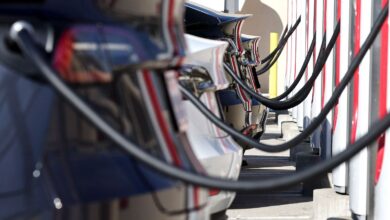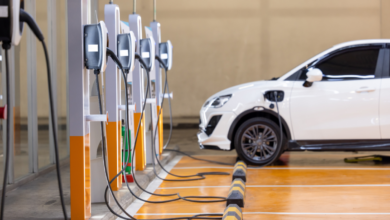The ethical dilemma of electric vehicles and mining : NPR

MANOUSH ZOMORODI, HOST:
It’s the TED Radio Hour from NPR. I’m Manoush Zomorodi. On the show today, Tech’s climate conundrum. We’ve all gotten the message. The era of gas-guzzling cars is slowly drawing to a close. Electric vehicles are the future.
(SOUNDBITE OF ARCHIVED RECORDING)
PRESIDENT JOE BIDEN: My administration is investing more than $135 billion to advance America’s electric vehicle future.
ZOMORODI: But we’ve also heard that the batteries needed to power these cars require rare minerals that are hard to get. And mining for those minerals is terrible for the environment. But it is that just the price we need to pay in the short term for the long-term benefit of transitioning to electric?
KIRK SIEGLER, BYLINE: The green energy transition, as it’s often called by the politicians, it’s actually maybe not as green as we once thought because it, too, will require a lot of mining.
ZOMORODI: We’re about to explore the trade-offs by tracing where exactly these minerals come from and how mining for them impacts the land and people who live there, starting with NPR correspondent Kirk Siegler, who’s been reporting from the site of a new mine in Nevada at a place called Thacker Pass.
(SOUNDBITE OF BIRD SINGING)
SIEGLER: It’s hard to describe just how vast it looks, even for someone who’s used to these big wide-open Western landscapes. It’s ringed by mountains, huge mountains with, you know, this massive carpet of 3- or 4-foot-high sagebrush plants that unfold on the horizon for as far as you can see.
ZOMORODI: Kirk says there’s a push here to mind these minerals for EVs and do it fast – minerals like cobalt, nickel, lithium, copper and graphite. Over the next 15 years, the U.S. government estimates the demand for lithium alone will increase by 4,000%.
SIEGLER: I mean, this is a huge amount of lithium in Nevada that’s sitting there in this deposit. It’s often said that it’s the largest lithium deposit in North America. And so now, all of a sudden, these lands that were largely forgotten are now very much in play, and it’s very much the center of controversy.
ZOMORODI: That controversy pitted a mining company called Lithium Americas and the U.S. Bureau of Land Management against environmentalists and some nearby Native tribes.
(SOUNDBITE OF ARCHIVED NPR BROADCAST)
SIEGLER: We’re at Thacker Pass, and we’ve got protesters blocking down here. We’ve got currently…
ZOMORODI: Back in 2021, Kirk talked to activists protesting at the site. One of them was Gary McKinney.
(SOUNDBITE OF ARCHIVED NPR BROADCAST)
GARY MCKINNEY: Right here, I’ve been camped here for about a month and a half now.
ZOMORODI: He’s against the mine because it’s on historic land and would destroy the natural environment.
(SOUNDBITE OF ARCHIVED NPR BROADCAST)
MCKINNEY: We can’t flush out all the water from out of here and rip up everything that is out here and call it green energy. That’s greenwashing. I’m prepared to stay out here and oppose this mine for as long as it takes – as long as it takes.
ZOMORODI: That fight lasted three years. Eventually, the mining lease was upheld in court, and excavation began in 2023. General Motors has signed on to buy all the lithium produced here in the first decade.
SIEGLER: One of the chairmen of one of the tribes put it to me this way, that Native Americans are once again being asked to get out of the way for American progress.
ELSA DOMINISH: Yeah. That story is really repeated across the globe, whether it’s South America or North America or Australia, across Asia.
ZOMORODI: This is Elsa Dominish. As a researcher for the Institute for Sustainable Futures in Sydney, Australia, she has a global perspective on the impact of mining and ideas about how to do it better. But she is quick to clarify that EVs are crucial to carbon reduction.
DOMINISH: So road transport is a huge emitter. It’s 10% of global emissions. And this sector’s grown more than any other end-use sector. So getting those emissions down is essential, and EVs are one of the technologies to do that, and they are a very important one.
(SOUNDBITE OF TED TALK)
DOMINISH: EVs are a good thing. There’s no question, and we need them as part of the transition.
ZOMORODI: Here she is on the TED stage.
(SOUNDBITE OF TED TALK)
DOMINISH: But in many ways, isn’t mining and overconsumption what got us into this problem? And now we’re trying to mine and consume our way out of it. So why does this matter? And surely, this mining isn’t as bad as mining fossil fuels. Well, yes, we need to put a halt to mining fossil fuels immediately. But it’s not about what type of mining is better or worse or more or less. All of it matters. Mining for the green transition has impacts, and that matters, too. We’re facing a climate crisis, but we’re also facing a biodiversity crisis. And many of these minerals are found in sensitive and fragile ecosystems.
Half of all these minerals are found on Indigenous lands. If we are doing this transition in the name of saving the planet, it should not come at the cost of sacrificing communities and ecosystems. And here, in Australia, we are the No. 1 lithium producer. But we by no means have a clean record in relation to mining, and we are a world leader when it comes to biodiversity loss. Lithium mining was even being considered under old-growth forests in Western Australia until community protests brought this to a halt. How much of the country do we want to keep digging up when so few wild places remain? Here and across the globe, mining continues to happen on lands sacred to Indigenous people who never had the option to say no.
ZOMORODI: OK, so lithium, we’ve talked about lithium. What are the other ones, other mines that you see being most problematic that are vital to making an electric car possible?
DOMINISH: Yeah. So cobalt is definitely the most widely known in terms of its impacts. Cobalt mining, 60, 70% of that is happening in the Democratic Republic of Congo. Here, there’s both industrial mining and also small-scale informal mining.
(SOUNDBITE OF ARCHIVED RECORDING)
UNIDENTIFIED PERSON #1: This is one of the thousands of unregulated unmonitored mines in the DRC.
UNIDENTIFIED PERSON #2: Sky News film children as young as four working in appalling conditions.
DOMINISH: People are digging hand-dug tunnels, which are extremely dangerous. They extend, you know, tens of meters underground. They’re obviously at risk of collapsing, of flooding and there are many kind of deaths that have gone unreported from these mines.
(SOUNDBITE OF PICKAXES)
DOMINISH: But the other big issue is industrial mines.
ZOMORODI: I mean, I have seen videos from these mines. It’s thousands of people shoulder to shoulder, digging with their hands, simple tools, hauling out minerals with buckets. People refer to it as modern-day slavery.
DOMINISH: Exactly. So, you know, a lot of these are foreign-owned. Workers here are exploited. They’re facing racism and violence, and the conditions are still unsafe. They’re also often paid as subcontractors, earning, you know, as little as $2.50 a day, which is below the living wage. And so they’re working, but they’re continuing to be trapped in poverty.
(SOUNDBITE OF TED TALK)
DOMINISH: Another mineral – nickel. Over half of the world’s nickel is found in Indonesia, and recently, $14 billion of international investment has poured in for new mines and smelters. Contaminated soil from the mines has turned the ocean red and brown. Land and crops have been destroyed, and sometimes the air is so polluted that it’s difficult to breathe. If we continue on the pathway that we are, we could need 40 times more nickel by 2040. Is that in any way feasible or sustainable? And even the remotest parts of the ocean are under threat from plans to mine the deep sea. Communities in the Pacific are leading a protest against this, worried about the impacts it could have. We don’t even understand the deep sea to know what we could potentially be destroying.
ZOMORODI: OK, so we’ve kind of laid out the conundrum here, which is we do need to get electric cars on the road. We have problems with how we are sourcing the materials we need to build those electric cars. So what do we do? What are the solutions? – I mean, without just, you know, shrugging our shoulders and saying, well, to play the long game, we have to make some sacrifices in the short term.
DOMINISH: Yeah. So from what we’ve looked at, the most important thing we can do is to reduce the amount of minerals we need. And to do this, the key thing is reducing our reliance on cars.
ZOMORODI: As an American, I have to chuckle at that…
DOMINISH: Exactly.
ZOMORODI: …Because telling people to give up their cars here, I mean, not only is it, like, the American way…
DOMINISH: Yeah.
ZOMORODI: …It’s just impossible in a lot of places in the United States.
DOMINISH: Yes, exactly. And I hear that a lot. I’m talking about, particularly in cities.
(SOUNDBITE OF TED TALK)
DOMINISH: Our transport system is already going to have to change. So why don’t we use this as an opportunity to redesign it to one that actually meets our needs instead of locking ourselves into a future based on cars and all the existing problems that we know they create? We need fewer cars, but we also need smaller cars. The bigger the car, the bigger the battery and the more mining that is required. A small EV might have a battery that weighs 300 kilograms. A big one could be two or three times that.
There are some companies in the U.S. that have even stopped manufacturing small EVs in order to make more large SUVs and trucks. It’s not because people don’t want to buy small EVs. They do. But it’s because the larger cars are more profitable. We also need to be designing them so that they can be repaired. Whole cars are being scrapped because of a problem with the battery. How is that sustainable? Swapping one car for another – it’s not going to solve our problems. Instead, we need to think differently, think bigger and change the whole system.
But if we make our cities easier to get around without needing to drive, if we make public transport convenient and safe and affordable and accessible, people will use it.
ZOMORODI: OK, so public transport, smaller cars. What about recycling? Does that play any part here?
DOMINISH: So there’s quite a few companies that are partnering, you know, manufacturers with battery manufacturers and recyclers in order to create closed-loop systems where batteries from end-of-life vehicles are collected. They’re recycled in a really high-value process, and then those minerals can go straight back into battery manufacturing.
ZOMORODI: Changing the entire transportation ecosystem is the long-term goal, but we’ll still need more minerals than ever before for EVs. So right now, people are working towards making mining possible, but changing how and where it gets done.
PATRICK DONNELLY: My organization has a half-dozen people who all day every day, they fight for electric vehicles and battery storage for the renewable energy transition. So we’re all in. And that means implicitly, we’re all in on lithium mining.
ZOMORODI: Patrick Donnelly heads the Nevada branch of the Center for Biological Diversity. He’s trying to stop another proposed lithium mine from opening on the site of an endangered wildflower.
DONNELLY: They chose to site it in the middle of an endangered species habitat, which they knew was there. And so people say, well, we don’t have time for a planning effort. No, we don’t have time for all these lithium companies to be messing around in court for a decade. So we really need leadership in order to get a plan in place for how we’re going to produce all this lithium without ruining the American West and driving species extinct and harming Indigenous communities.
ZOMORODI: Patrick points to an example in California as a model for how all sides – the government, industry and conservationists – can negotiate and find solutions that work for everyone. This was back in 2014, and the issue was solar, but the debate was similar.
DONNELLY: Lots of controversy. There was lots of litigation. Solar energy was, like, not taking off in the desert, and especially in California, the way it was desired. And they basically looked at the whole California desert and said, where are the places we can put solar with the least impact, and where are the places that are so sensitive we should never put solar? And in the end, they came up with a plan that designated half a million acres, which was more than enough for 20 years’ worth of solar development by their estimations.
It also designated 2.5 million acres for conservation. So in other words, to compensate the desert for losing half a million acres to solar, 2.5 million acres would be permanently conserved. What that did was really bring about a detente in the solar wars. And so that’s functionally what we need for lithium. If we frontload that work and expense on planning to begin with, we can actually end up with a much cheaper, faster and more environmentally sound clean energy transition.
ZOMORODI: When it comes to mining for EV batteries, deliberate, hard negotiation, and compromise, he says, need to urgently happen, too. It won’t be easy.
That was Patrick Donnelly from the Nevada branch of the Center for Biological Diversity, Elsa Dominish from the Institute for Sustainable Futures and NPR correspondent Kirk Siegler. The audio you heard from Industrial mining in the Democratic Republic of Congo came from Siddharth Kara and an episode by our colleagues at THROUGHLINE about the history of extracting resources from the DRC called The Ghost In Your Phone. It is really worth a listen.
Copyright © 2024 NPR. All rights reserved. Visit our website terms of use and permissions pages at www.npr.org for further information.
NPR transcripts are created on a rush deadline by an NPR contractor. This text may not be in its final form and may be updated or revised in the future. Accuracy and availability may vary. The authoritative record of NPR’s programming is the audio record.



